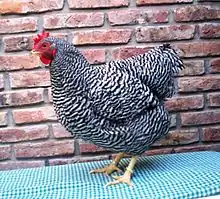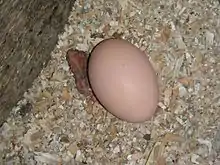Plymouth Rock chicken
The Plymouth Rock is an American breed of domestic chicken. It was first seen in Massachusetts in the nineteenth century, and for much of the early twentieth century was the most popular chicken breed in the United States. It is a dual-purpose breed, raised both for its meat and for its brown eggs. It is resistant to cold, easy to manage, and a good sitter.[2][6]:68
 Plymouth Rock Hen, Barred plumage | |
| Conservation status | Recovering |
|---|---|
| Other names | Rock Barred Rock |
| Country of origin | United States |
| Standard | |
| Use | Dual-purpose breed |
| Traits | |
| Weight | |
| Skin color | Yellow |
| Egg color | Brown[2] |
| Comb type | Single |
| Classification | |
| APA | American[3] |
| ABA | Single comb clean legged |
| EE | yes[4] |
| PCGB | Soft feather: heavy[5] |
| APS | heavy breed softfeather |
| |


History
The Plymouth Rock was first shown in Boston in 1849, but was then not seen for another twenty years.[2] In 1869, in Worcester, Massachusetts, one D.A. Upham cross-bred some Black Java hens with a cock with barred plumage and a single comb; he selectively bred for barred plumage and clean (featherless) legs.[6]:68 His birds were shown in Worcester in 1869; the modern Plymouth Rock is thought to derive from them.[2] Other people have been associated with the development of the Plymouth Rock, as have other chicken breeds including the Brahma, the Cochin (both white and buff), the Dominique, and the White-faced Black Spanish.[2]
The Plymouth Rock was added to the Standard of Excellence of the American Poultry Association in 1874.[2] The barred plumage pattern was the original one; other colors were later added.[2]
Because of its many good qualities – tasty meat, good egg production, resistance to cold, early feathering, easy management, good sitting – the Plymouth Rock became the most widespread chicken breed in the United States until the time of World War II.[2] With the advent of industrial chicken farming, it was much used in the development of broiler hybrids, but began to fall in popularity as a domestic fowl.[6]:68
The Plymouth Rock is listed by the Livestock Conservancy as "recovering", meaning that there are at least 2500 new registrations per year. Worldwide, numbers for the Plymouth Rock are reported at almost 33,000;[7] about 24,000 are reported for the Barred Plymouth Rock,[8] and over 970,000 for the White variety.[9]
Characteristics
The Plymouth Rock has a single comb with five points; the comb, wattles and ear-lobes are bright red. The legs are yellow and unfeathered. The beak is yellow or horn-colored.[6]:69 The back is long and broad, and the breast fairly deep.[10]
In the United States, seven color varieties of the Plymouth Rock are recognized: barred, blue, buff, Columbian, partridge, silver-penciled and white.[3] Ten plumage varieties are listed by the Entente Européenne d’Aviculture et de Cuniculture, of which five – barred, black, buff, Columbian and white – are recognized by the Poultry Club of Great Britain.[4] In Australia, the barred variant is split into two separate colors, dark barred and light barred.[11]
Use
The Plymouth Rock is a dual-purpose breed, and is kept both for its meat and for its large brown eggs, of which it lays about 200 per year.[2]
Plymouth Rock Chickens are commonly used for mass egg and meat production. Specifically, the White Plymouth Rock because it has been selectively bred for industrial production and studies suggest they statistically yield more eggs and meat compared to other variations of the Plymouth Rock.[12] In addition, their docile nature and hardiness make them an easily mass-produced and raised species. Barred Plymouth Rocks are seeing negative population trend in industries while White Plymouth Rocks are seeing a sharp positive trend.[10] White Plymouth Rocks are crossed with Cornish chickens to create the "chicken" in the grocery store.
References
| Wikimedia Commons has media related to Plymouth Rock (chicken). |
- Victoria Roberts (2008). British poultry standards: complete specifications and judging points of all standardized breeds and varieties of poultry as compiled by the specialist breed clubs and recognised by the Poultry Club of Great Britain. Oxford: Blackwell. ISBN 9781405156424.
- Plymouth Rock Chicken The Livestock Conservancy. Archived 10 October 2016.
- APA Recognized Breeds and Varieties: As of January 1, 2012. American Poultry Association. Archived 4 November 2017.
- Liste des races et variétés homologuée dans les pays EE (28.04.2013). Entente Européenne d’Aviculture et de Cuniculture. Archived 16 June 2013.
- Breed Classification. Poultry Club of Great Britain. Archived 12 June 2018.
- Carol Ekarius (2007). Storey's Illustrated Guide to Poultry Breeds. North Adams, Massachusetts: Storey Publishing. ISBN 9781580176675.
- Transboundary breed: Plymouth Rock. Domestic Animal Diversity Information System of the Food and Agriculture Organization of the United Nations. Accessed October 2016.
- Transboundary breed: Plymouth Rock Barred. Domestic Animal Diversity Information System of the Food and Agriculture Organization of the United Nations. Accessed October 2016.
- Transboundary breed: Plymouth Rock White. Domestic Animal Diversity Information System of the Food and Agriculture Organization of the United Nations. Accessed October 2016.
- Janet Vorwald Dohner (2001). The Encyclopedia of Historic and Endangered Livestock and Poultry Breeds. New Haven, Connecticut; London: Yale University Press. ISBN 0300088809.
- James Bishop (1998). Australian Poultry Standard, first edition. Linton, Victoria: Victorian Poultry Fanciers' Association. ISBN 9780646362311.
- Peter Hric, Cyril Hrnčár, Jozef Bujko (2012). Diversity in Population Size and Production Parameters of Selected Varieties of Plymouth Rock Chicken Breed. Scientific Papers Animal Science and Biotechnologies 45 (1): 189–192. ISSN 2344-4576.